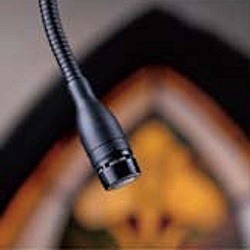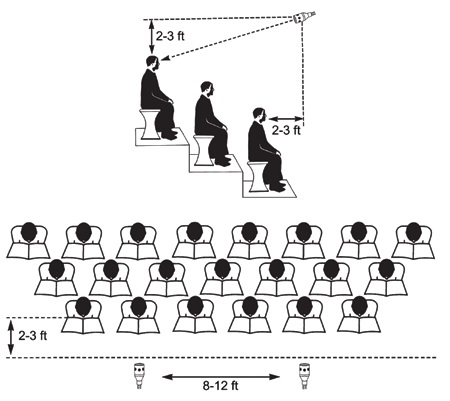
Another bit of advice is to try to have singers spaced with shoulders lightly touching, which has proven to improve group vocal unity, in addition to closing any gaps and/odd spacing that might impact mic performance.
“Finding the ideal number and location of mics for each environment requires practice and experience. Equally important is an understanding of the musical style and intended effect,” points out Kent Margraves of Sennheiser USA. “Standing, moving about, and listening right in front of the choir during rehearsal or sound check can help discover useful placement.
A word of guidance if the mics are to be permanently installed from the ceiling – first, place them on tall stands that can be moved around the choir area to find optimum locations.
If hanging the mics is not an option, note that some manufacturers now offer solutions that utilize a small condenser mic integrated on to a long slender boom arm, thereby offering required height with added mobility.
If the mics are flown from the ceiling, they often need to be held in position. Mic cables can lose their orientation as they uncoil over time, be affected by factors like temperature and humidity, and can swing back and forth in a breeze.
As a result, some have a built-in hanger which comes with a tiny crossbar or pipe. Threading fishing line through this pipe and attaching it to screw hooks in side walls creates a guy-wire that keeps the mics properly oriented.

“Whether hanging or placing the mics on floor stands, the ideal location and orientation are the same,” notes Margraves. “And, the finest choir mics on the planet just won’t work if they are not positioned well. There is also no perfect mic placement that works for every choir environment.”
Location & Strategy
Monitoring for the choir can be important – hearing the worship leader for cueing and timing, getting pitch and rhythm, or hearing pre-recorded tracks, as well as being able to hear the pastoral staff when they speak.
Yet monitor loudspeakers can feed back into the choir mics, so the location of monitors, and the strategies in using them, are factors deserving attention when talking about choir mic’ing.
Houck suggests, “Do not position the monitors behind the choir. They get picked up too easily by the mics, reducing the desired clarity. It is best to put the least amount of instrumentation or recording into the monitor – just enough to get pitch and tempo.
“Also make sure the choir practices with the same mix as when the actual service is. By all means, do not put the choir into the monitor mix. This will cause feedback and also cause the singers to not sing as loud.”
